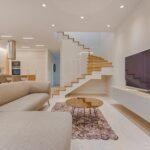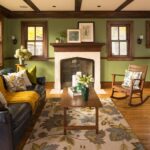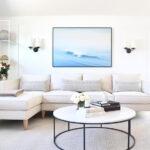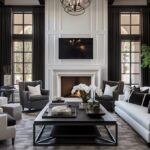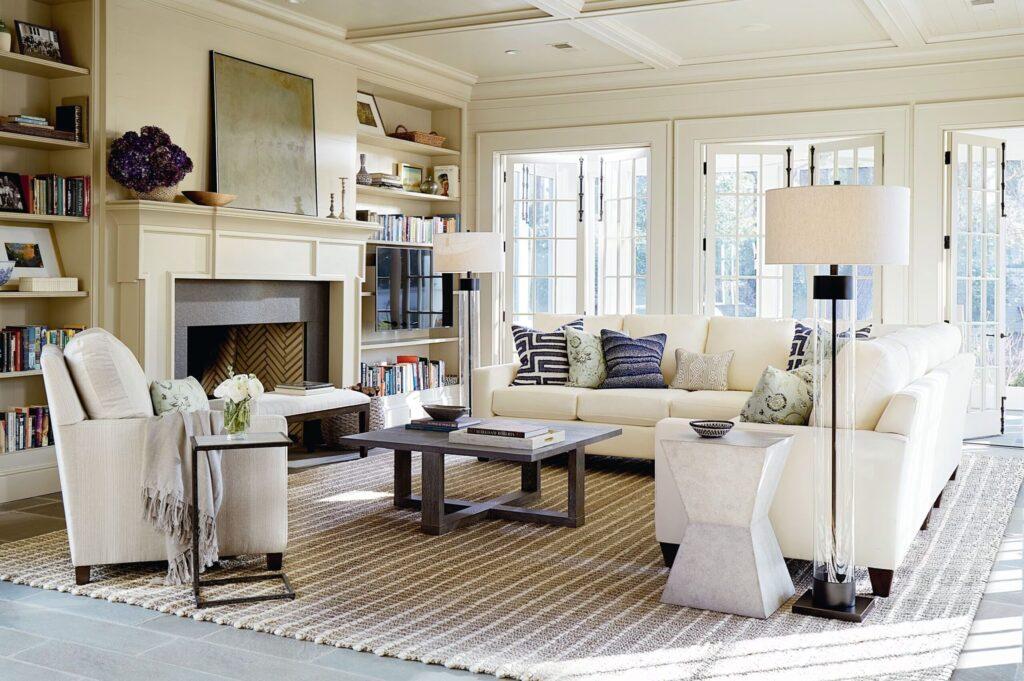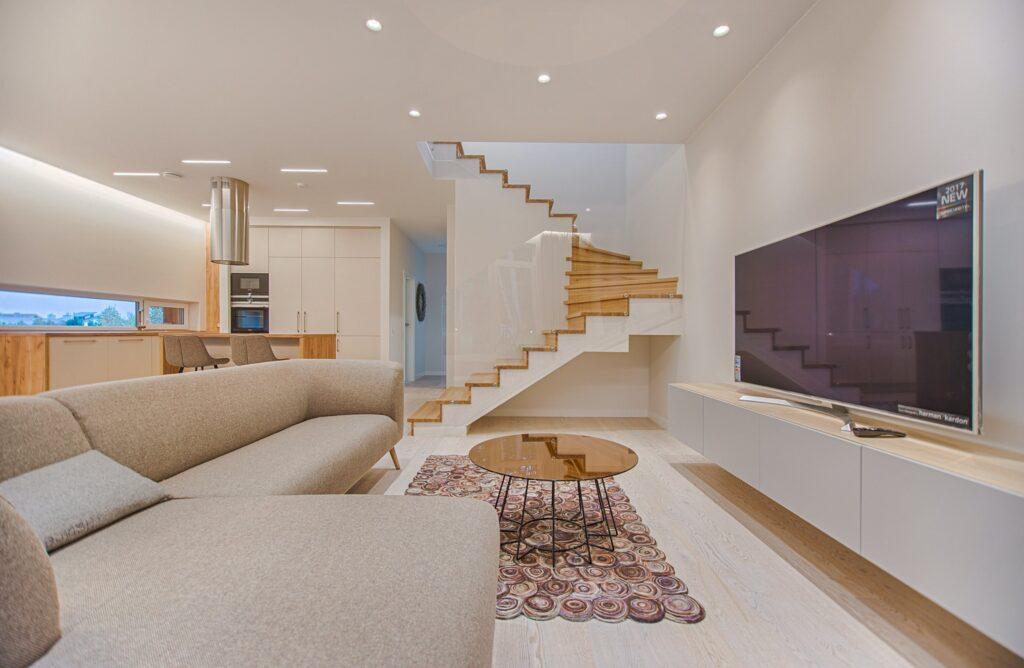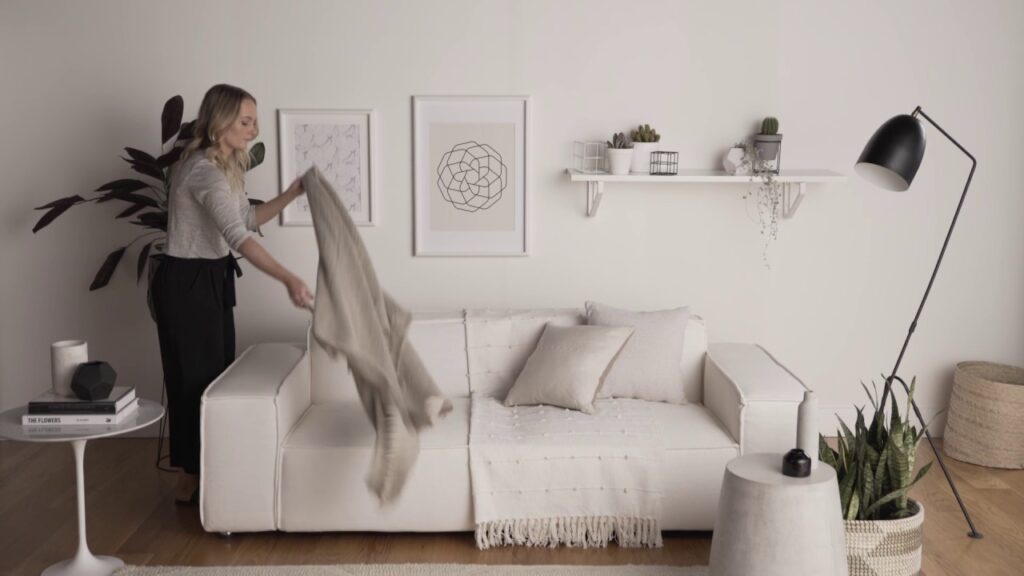Finding the right way to arrange living room furniture can transform your space from cluttered chaos to serene sanctuary. A well-arranged living room promotes relaxation, conversation, and a free-flowing traffic pattern. Below are some handy tips and insights on how best to arrange living room furniture, providing you with a perfect blend of functional style and comfort.
- Choosing a Focal Point: A focal point directs attention and attracts visitors upon entering the space.
- Arrangement Ideas for Large Rooms: Utilize your large living room space properly by creating areas for lounging, conversation, and entertainment.
- Layouts for Small Spaces: Small spaces require clever placement of furniture to maximize room potential.
- Placement of Furniture on Rugs: Using rugs effectively can define separate areas in your living room.
- Furniture for Optimal Conversation: Positioning your furniture for optimal conversation creates an inviting atmosphere for guests.
- Creating Attractive Traffic Flow: Proper furniture arrangement can guide movement and create an attractive traffic flow in the living area.
Applying these tips can significantly enhance the harmony and functionality of your living space. So, let’s delve further into the art of arranging living room furniture.
Detailed Guide on Living Room Furniture Arrangement
A remarkable living room layout begins with a strategy.
Your chosen focal point should be engaging, whether it’s a stunning work of art, a charming fireplace, or a beautiful window view.
Large rooms can be made cozier by creating defined areas, while smart furniture placements can give small rooms an illusion of space.
Rugs not only add warmth but also help define functional areas in an open space.
Contents
- Choosing a Focal Point for Furniture
- Arrangement Ideas for Large Living Rooms
- Layouts for Small Living Room Spaces
- Placement of Furniture on Rugs
- Arranging Furniture for Optimal Conversation
- Proper Furniture Layout for Lounging
- Creating Attractive Traffic Flow with Furniture
- Solving Common Furniture Arrangement Challenges
- Mastering Open Concepts
Choosing a Focal Point for Furniture
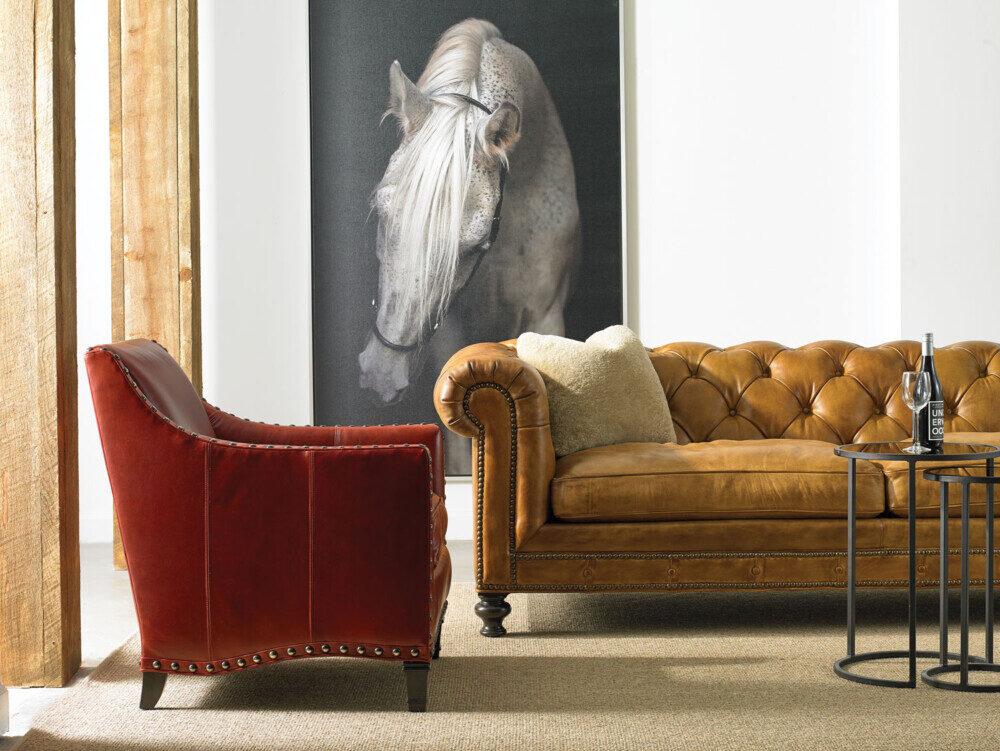
Every room, regardless of size, requires a compelling focal point. This feature captures the eye, inviting you into the space.
An impactful focal point could be an item as simple as a plush sofa or an ornate piece of art. Alternatively, it could be an architectural structure such as an accent wall or expansive window.
Your chosen focal point serves as the foundation from which you arrange your furniture. Begin with your most substantial piece, ordinarily the sofa, and design around it.
The layout might place your armchairs opposing the sofa with a coffee table nestled in between. Exploit differing arrangements to see what works for you and your space.
A key consideration throughout this process is comfort. Foresee how others would feel in your proposed setup and make appropriate adjustments if any discomfort arises.
In many homes, furniture gravitates around either a television or fireplace. Determining whether either of these elements should serve as your living room’s focal point depends on individual preference and lifestyle considerations.
Once you settle on the element to highlight, position seating units directly towards it. This intentional placement ensures those situated there can appreciate your carefully selected focal point.
Finding the right balance when arranging furniture can create a harmonious and inviting living space. For more inspired ideas, check out this resource.
Arrangement Ideas for Large Living Rooms
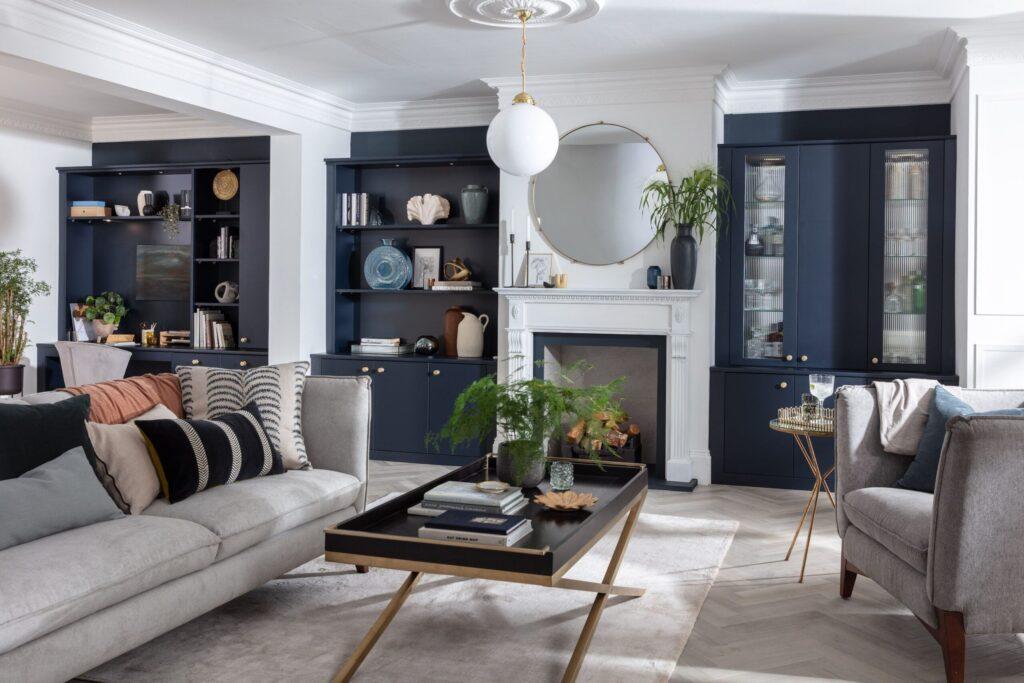
How can I plan my space effectively?
Planning your space effectively is the first step.
Create a furniture layout that works with the room’s size and shape.
Sketch out a plan on paper to visualize the setup.
What are some arrangement options?
An anchor piece like a sofa can set the tone.
Add coffee tables, armchairs, or ottomans to create balance.
Large rugs can help define different seating areas within the room.
What about storage pieces?
Storage furniture can be stylish and functional in large spaces.
Sleek entertainment units, sideboards, or bookcases can fill empty spaces beautifully.
Avoid overwhelming the room; choose pieces that complement your aesthetic.
How do I use decorative elements?
Cushions, throws and artwork add visual interest.
Pick pieces that enhance your color scheme and theme.
Avoid clutter; opt for a few key items that express your style.
Can lighting influence the arrangement?
Certainly! Strategic lighting lifts a room’s ambiance.
Lamps can accentuate specific areas or pieces of furniture.
Consider multiple sources for layered lighting effects.
Any tips for maintaining flow?
The right furniture arrangement also ensures easy movement.
Maintain clear paths for walking and avoid blocking exits.
Create natural conversation areas for socializing with guests.
Layouts for Small Living Room Spaces
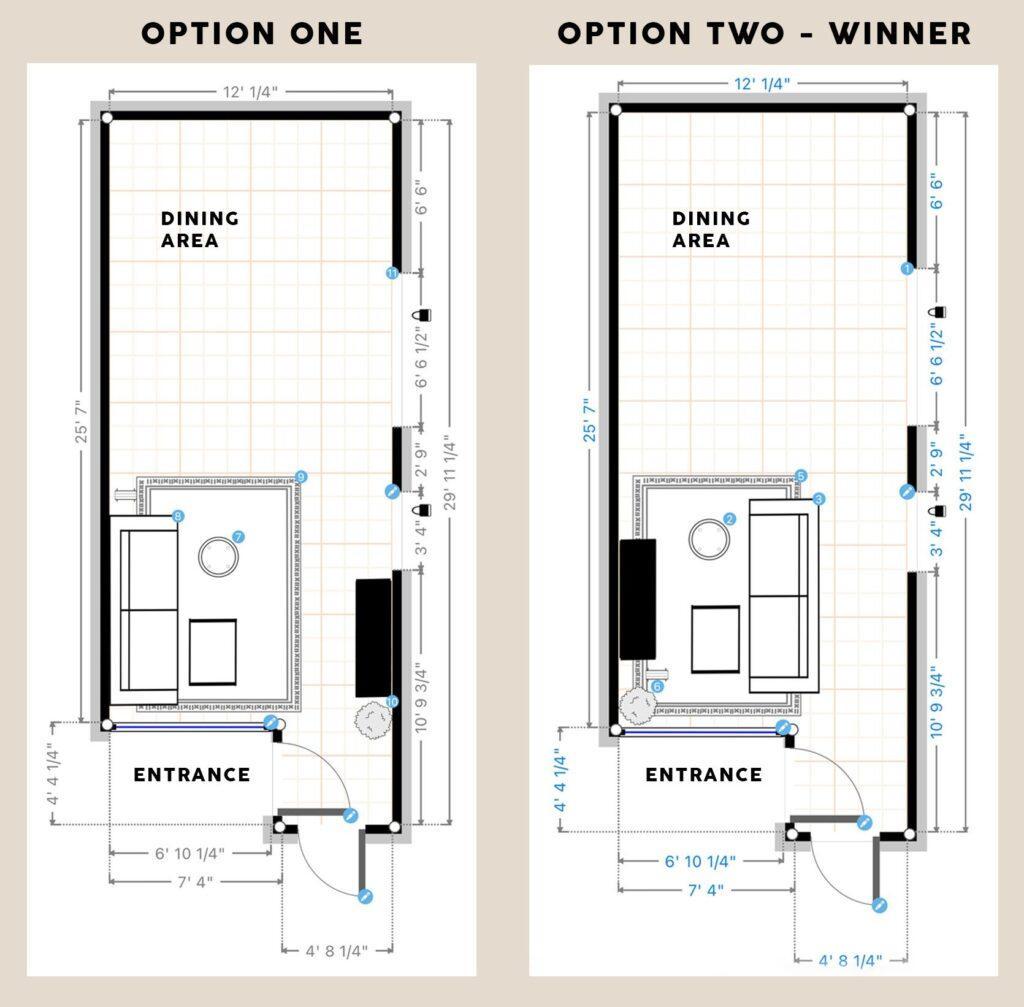
The secret to maximizing small living rooms is picking multifunctional pieces. Opt for a coffee table with built-in storage to up functionality whilst enhancing style.
Tackling vertical space can be tricky, but it’s achievable by substituting stand-alone lamps with floor lamps. This way, you make the most of the available floor area.
Chairs with legs can be your next best friend. Incredibly, they give your room an illusion of spaciousness just by being off the ground a little bit.
Mirrors are a decorator’s magic wand – placed strategically; they can visually expand your living room.
Your choice of color also plays a significant role in how spacious your living room feels. Light grays, pastels, or creamy whites can make any space appear larger than it actually is.
A cozy and efficient seating solution is compact booths. They occupy less space compared to standard chairs, yet provide equal comfort.
Corner shelves, particularly floating ones, maximize corner spaces leaving you with more floor area.
One sure way of saving on space is by deploying foldable furniture. They serve purpose beautifully and can be tucked away when not in use.
Don’t overlook the potential of window seating. Long storage-style seats make good lounging areas without eating up much floor space.
Placement of Furniture on Rugs
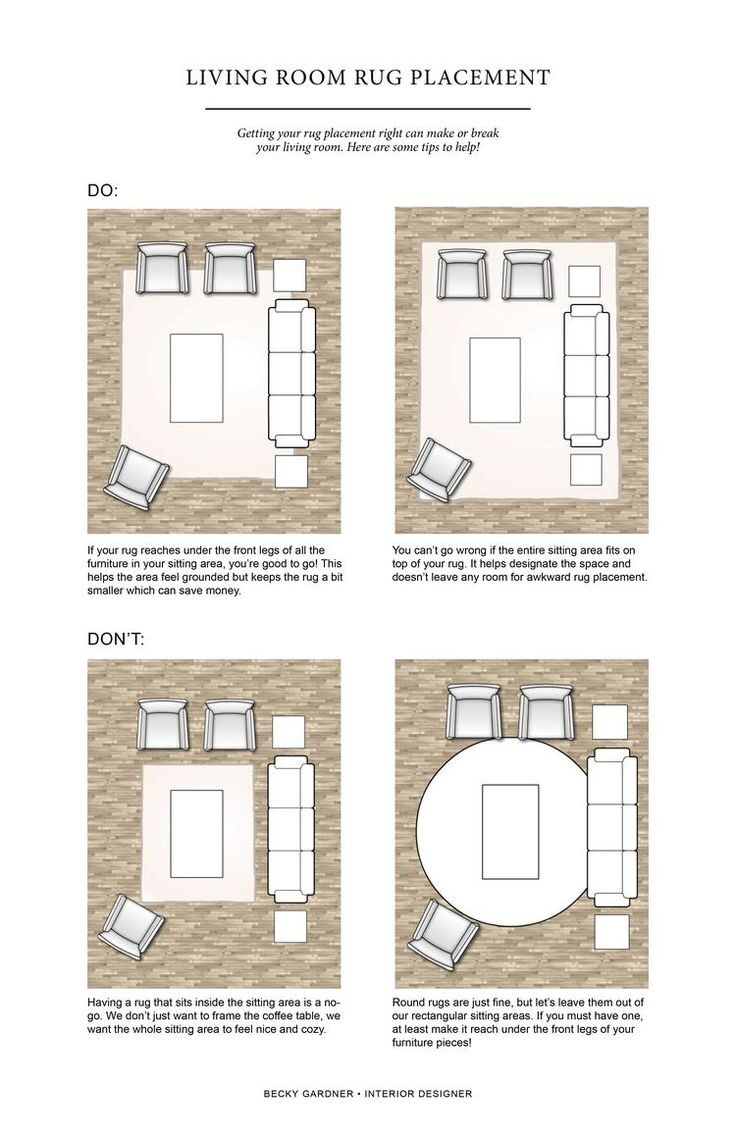
When it comes to the placement of furniture on rugs, there’s a fine balance to strike.
You don’t want to completely cover your new flooring, but the rug plays a crucial role in defining the space.
- The Sofa: The back of the sofa should at least touch the edge of the rug.
- The Chaise Lounge: It’s ideal if it can sit fully or partially on the rug.
- The Large Armchair: Having this piece on the rug helps maintain balance in furniture arrangement.
- Rug Size: Size should be proportional to the room and its function, without obscuring a significant portion of your beautiful floor.
Think about how you use your living space. This will guide you in positioning your furniture and rugs for maximum comfort and aesthetic appeal.
Your rug serves as an anchor point for your living room furniture. It helps provide a sense of cohesion among all the different elements present.
Every decision about furniture placement on rugs depends heavily on room size, so taking measurements will aid you significantly.
Create visual interest by positioning your pieces in a way that encourages conversation and interaction.
Arranging Furniture for Optimal Conversation
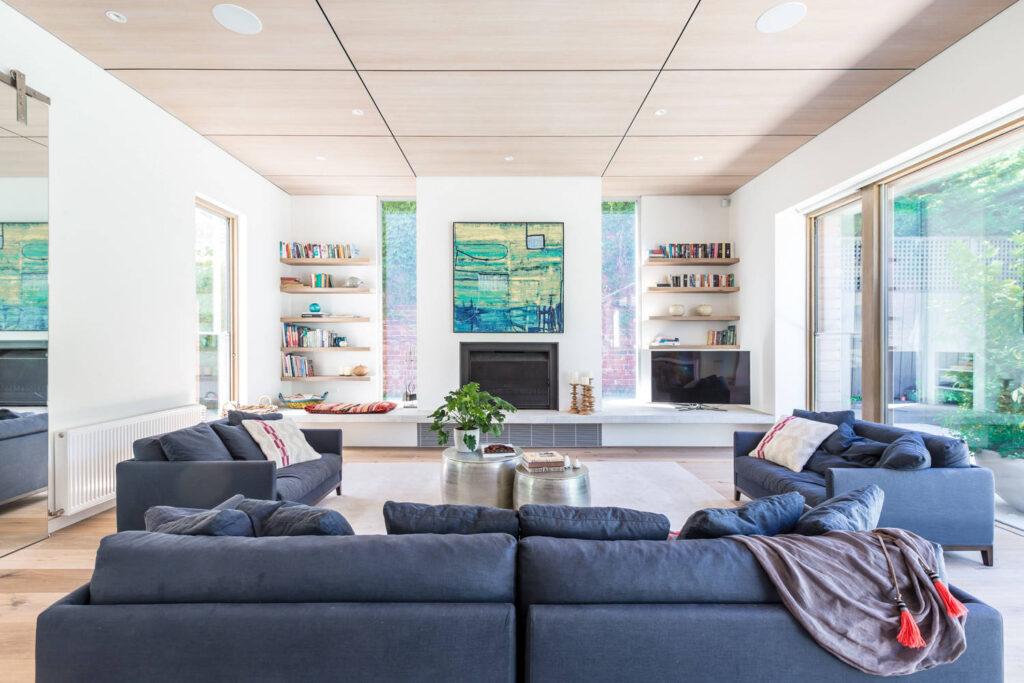
Let’s start with the focal point, the couch. Arrange it appropriately to set the desired atmosphere.
Symmetry creates harmony, so make it your best friend in interior design.
If you have two rooms that connect, always ensure one side is open. This avoids visual obstruction and enhances flow.
Rugs can be potent tools too. They effectively define conversation zones and guide movement within the room.
In spacious living rooms, maintain good space between furniture items. It aids natural conversation flow and promotes comfort.
| Furniture Item | Arrangement Strategy | Benefits |
|---|---|---|
| Couch | Centrally placed as a focal point | Sets conversational tone |
| Rugs | Define zones and guide traffic flow | Enhances navigation and zoning |
| Symmetry | Create symmetry between furniture pieces | Promotes harmony & balance |
| Open Space | Ensure one side of connecting rooms is open | Avoids visual obstruction & maintains flow |
| Spacing Out Furniture | Maintain good space in larger rooms | Promotes comfortable conversation & interaction |
| Table 1: Furniture arrangement strategies for optimal conversation. | ||
Remember, a well-planned layout, considering room’s function and space availability, is key to a conducive conversation environment.
To get a deeper sense of these strategies, you may want to check this insightful resource from Real Homes.
Proper Furniture Layout for Lounging
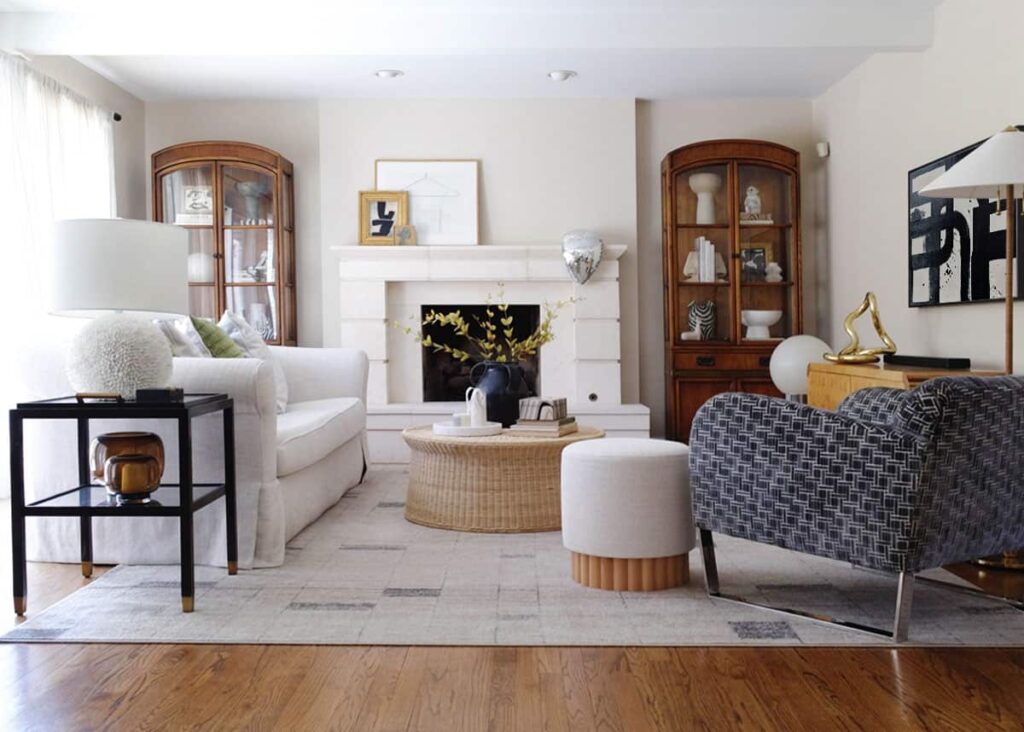
Optimal lounging needs a well-designed furniture layout. Let’s explore some ideas on how to achieve this.
Symmetrical Seating
A balanced look is achievable by placing identical chairs or sofas on opposite sides of a coffee table.
Creating a Focal Point
Designate a statement piece, like a fireplace or television, as the room center, and arrange furniture around it.
Considering the Flow
Ensure there’s a clear path of travel through the room for easy movement.
Setting up a cozy corner with a small chair, side table, and floor lamps creates an inviting spot for relaxation.
Incorporate multi-functional furniture pieces that can be rearranged easily. For instance, at storage ottoman changes purpose depending on your needs.
Arrange your furniture in a gradual arc. Positioning from taller to shorter items creates an eye-pleasing flow.
About 3 feet of space between pieces ensures comfortable movement within the area.
If you have a large room, use area rugs and separate seating areas to divide it into zones. This will provide distinct sections without making it feel crowded.
Corners shouldn’t go to waste. Placing a console table, storage cabinet, or small desk utilizes these often-overlooked spaces efficiently.
Avoid overcrowding by distributing furniture evenly. This maintains a fresh sense of space, perfect for relaxing and socializing.
Creating Attractive Traffic Flow with Furniture
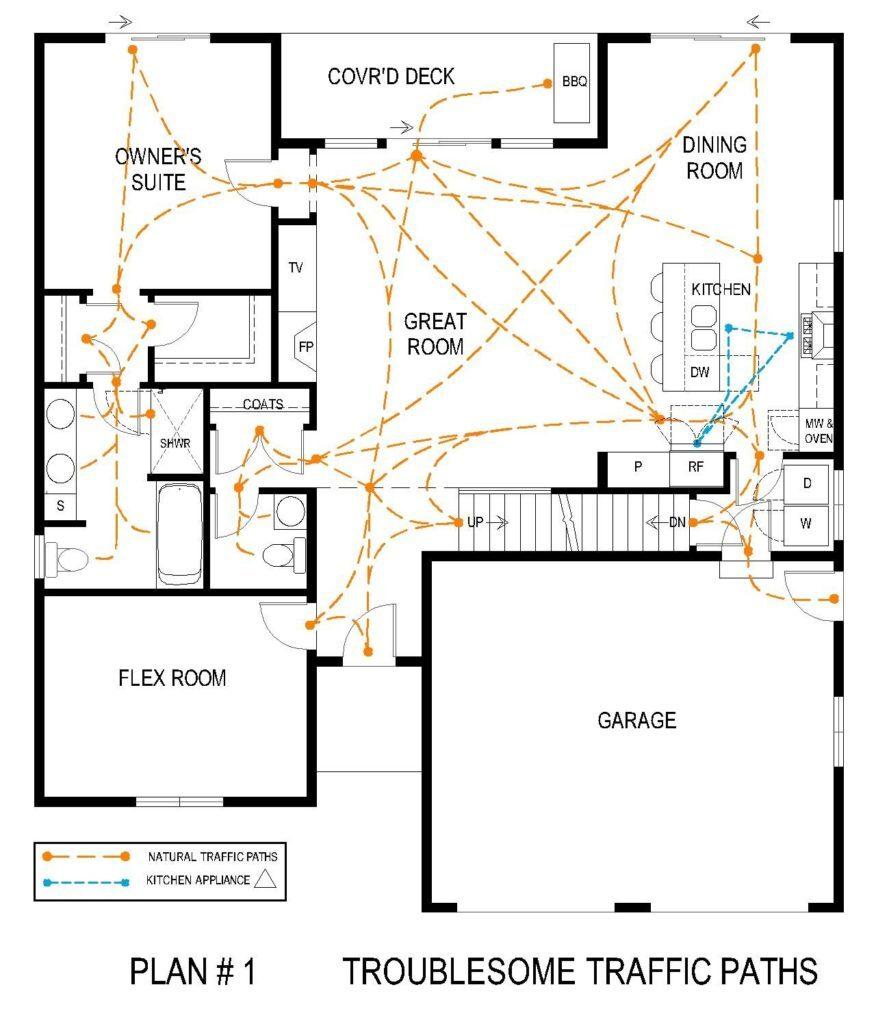
An innovative approach to arranging furniture breathes life into your living room. This requires creativity and strategy, much like styling outdoor furniture.
You can create an illusion of a swinging couch by employing a few tricks. This design tip certainly adds a whimsical charm.
Such unique furniture placements not only capture attention but also direct traffic flow dynamically. Now, let’s consider four key points:
- Mimic Outdoor Furniture: Replicate the casual vibe of outdoor arrangements for a relaxed feel.
- Rope Tricks: Attach ropes from the arm of a couch to the ceiling to mimic swinging couches.
- Focal Points: Unique elements draw attention and attract footfall, driving the flow in your room.
- Creative Movements: Do away with traditional seating arrangements and encourage dynamic movements.
Your living room is your canvas; don’t shy away from experimenting with out-of-the-box ideas.
A well-thought-out layout is crucial for enhancing your space’s visual appeal while catering to functionality needs.
The right arrangement can make a world of difference in setting the desired ambiance. Each piece of furniture plays a vital role in this process.
Regardless of how beautiful individual pieces may be, it is how they come together that truly matters. Cooperation between different elements leads to harmony in design.
So, ponder over these tips as you embark on your furniture arrangement journey. And remember, there are no hard-set rules when it comes to creative endeavors!
Solving Common Furniture Arrangement Challenges
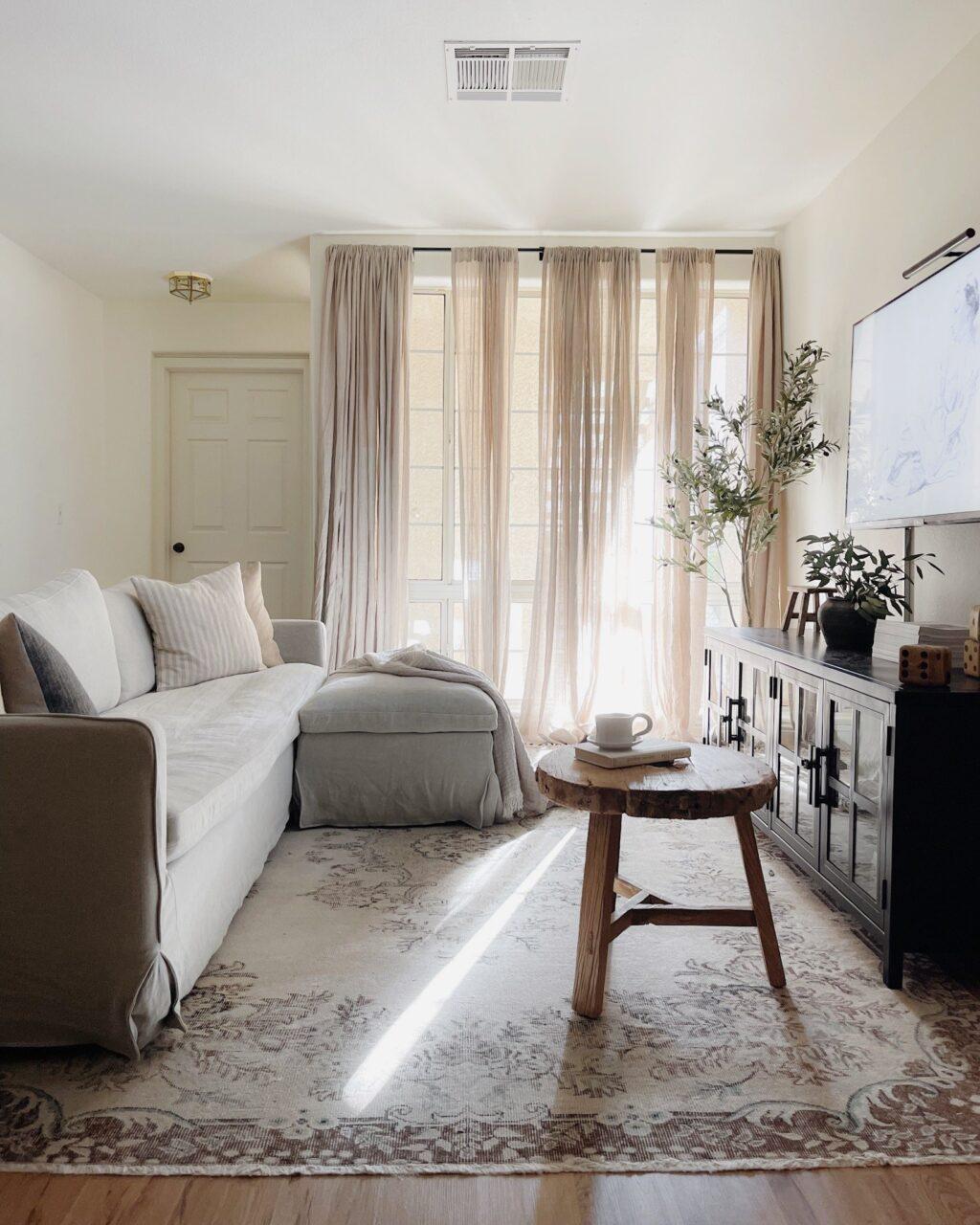
One of the most common hurdles in arranging living room furniture is creating an illusion of space.
Positioning seating furniture, such as sofas and chairs, near a window can aid in achieving this.
Mirroring Outdoor Space
In the Los Angeles loft of Amanda Gunawan, for example, a CB2 sectional and Charles and Ray Eames chair were placed right next to the window.
This clever positioning made the room feel more spacious while showing off a beautiful sun-drenched aesthetic.
Keeping it Simple
Remember that simplicity often wins. Striking yet straightforward setups can make your living room feel truly special.
Consider Shawn Henderson’s upstate New York home, where a Kaare Klint sofa and a Kerstin Hörlin-Holmquist armchair create a simple but awe-inspiring ambiance.
The Power of Doubling
Why only have one coffee table when you can have two? This trick allows guests to engage in separate conversations without interruption.
In this setup, two gilded coffee tables pair perfectly with an Art Deco armchair, a custom sofa, and Edward Wormley chairs for Dunbar.
Moving away from conventional layouts can result in unique and refreshing living room arrangements.
The Art of Sectioning
If you’re dealing with limited space, consider using sectionals. Like Charlie Ferrer’s West Chelsea studio in Manhattan, where he used a wall-to-wall sectional to enhance the illusion of space.
This creative arrangement allows for maximum utility of small living spaces.
Craftsmanship with Style
A welcoming Craftsman-style living room can be achieved with thoughtful arrangement and selection of furniture, as demonstrated in a cozy Austin, Texas abode.
Sculptural wooden tables paired with leather side chairs create a welcoming and elegant atmosphere.
Blend Modern with Eclectic
Interiors by Design presented a fun, modern living room setup that strikes the perfect balance between chic and comfortable.
The combination of modern aesthetics and eclectic decor resulted in a lively yet refined ambiance.
A Touch of Farmhouse
For fans of the modern farmhouse look, using rustic pieces in your arrangement can make your living room warm and inviting.
This approach was masterfully executed by Tom Stringer Design Partners, resulting in a stunning modern farmhouse living room.
Mastering Open Concepts
Nailing the arrangement of living room furniture in open concept spaces hinges on defining areas without walls. Experiment with positioning, use rugs to anchor different zones, and ensure there’s a natural flow by aligning furniture pieces with architectural features. Remember, less can be more – open concepts thrive on airy, uncluttered designs.


